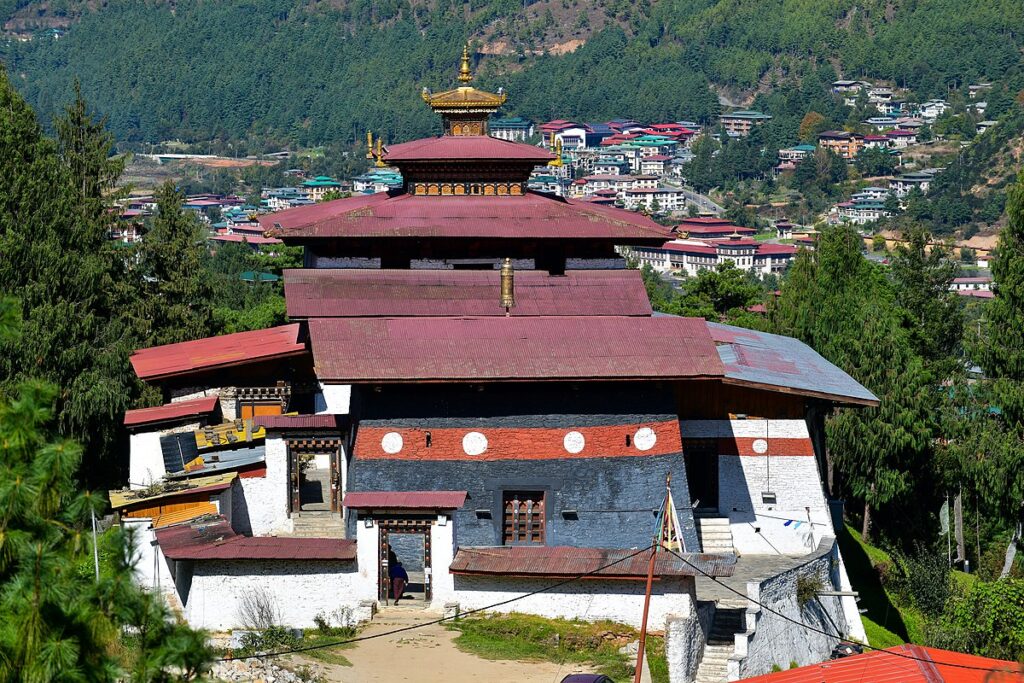
Changangkha Lhakhang

Changangkha Lhakhang is an ancient Buddhist temple located in Thimphu, the capital city of Bhutan. Here are some key details about Changangkha Lhakhang:
Location and History
- Location: It is situated on a ridge overlooking Thimphu Valley, providing panoramic views of the surrounding mountains and the city below.
- Founding: Changangkha Lhakhang is one of the oldest temples in Thimphu, dating back to the 12th century. It was founded by Lama Phajo Drukgom Shigpo, who is believed to be a descendant of Phajo Drugom Zhigpo, the founder of the Drukpa Kagyu school of Buddhism in Bhutan.
Architectural Features
- Design: The temple follows traditional Bhutanese architecture, with intricate wood carvings and murals depicting Buddhist teachings and mythological stories.
- Central Shrine: The main shrine in Changangkha Lhakhang houses a central statue of Chenrezig (Avalokiteshvara), the compassionate bodhisattva of compassion.
Religious Significance
- Spiritual Practices: The Changangkha Lhakhang temple is rooted deep into the local culture and customs and is an indispensable part of the local community. The temple is often frequented by parents with small children seeking to obtain blessings from the protective deity of the temple, Genyen Domtsangpa, who is considered to be the birth deity and protector of children born in JDWNRH national referral hospital in Thimphu Architectural Features
- Monastic Life: Changangkha Lhakhang also serves as a place of monastic learning and meditation, with monks residing in the temple and engaging in daily rituals and prayers.
Visitor Experience
- Scenic Views: Besides its religious significance, the temple offers stunning views of Thimphu Valley, making it a peaceful and picturesque place to visit.
- Cultural Insight: Visiting Changangkha Lhakhang provides insights into Bhutanese Buddhist traditions and customs, particularly the importance of spiritual practices in daily life.
Practical Information
- Visiting Hours: The temple is typically open to visitors during daylight hours. It is respectful to dress modestly and remove shoes before entering the temple premises.
- Accessibility: It’s accessible by road, though visitors should be prepared for a short uphill walk from the parking area to the temple.
Related
- Buddha Point
- Changangkha Lhakhang
- Cheri Monastery
- Choki Traditional Art School
- Coronation Park
- Dochula Pass
- Handicrafts Market
- Institute of Zorig Chusum
- Jungshi Handmade Paper Factory
- King’s Memorial chorten
- Lampelri Botanical Garden
- Lungchuzekha Goemba
- National library
- National Textile Museum
- Pangrizampa Monastery
- Phajoding Goemba
- Sangaygang View Point
- Serbithang Botanical Garden
- Simply Bhutan Museum
- Simtokha Dzong
- Takin Preserve Center
- Tango Monastery
- The Bhutan Postal Museum
- The Clock Tower Square
- The Folk Heritage Museum
- Traditional Medicine Institute
- Trashichhoedzong
- Wangditse loop
- Zangthopelri Lhakhang
- Zilukha Nunnery
Need Assistance?
Need Help? Call us or drop a message. Our agents will be in touch shortly.
Call Us : +975-17351324
+975-17495729
Email Us : adbhutantours@gmail.com
Call Us : +975-17351324
+975-17495729
Email Us : adbhutantours@gmail.com
Send your Queries
